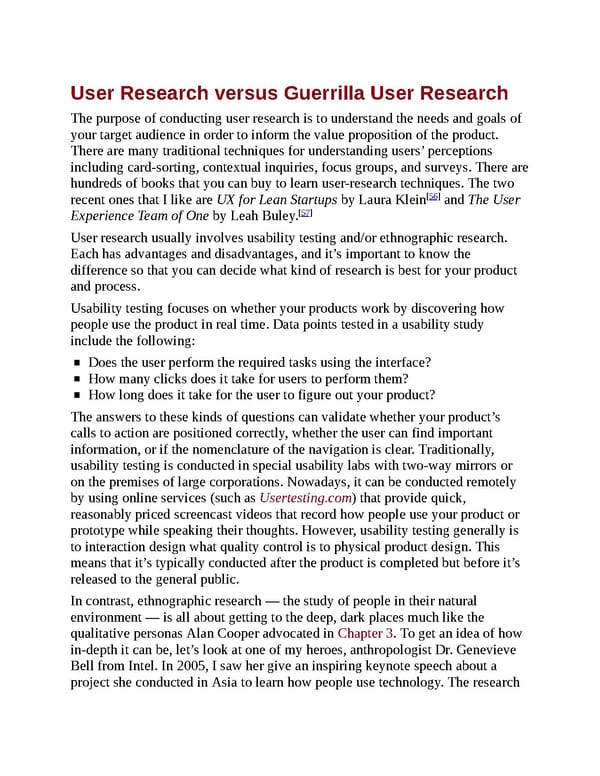User Research versus Guerrilla User Research The purpose of conducting user research is to understand the needs and goals of your target audience in order to inform the value proposition of the product. There are many traditional techniques for understanding users’ perceptions including card-sorting, contextual inquiries, focus groups, and surveys. There are hundreds of books that you can buy to learn user-research techniques. The two [56] recent ones that I like are UX for Lean Startups by Laura Klein and The User [57] Experience Team of One by Leah Buley. User research usually involves usability testing and/or ethnographic research. Each has advantages and disadvantages, and it’s important to know the difference so that you can decide what kind of research is best for your product and process. Usability testing focuses on whether your products work by discovering how people use the product in real time. Data points tested in a usability study include the following: Does the user perform the required tasks using the interface? How many clicks does it take for users to perform them? How long does it take for the user to figure out your product? The answers to these kinds of questions can validate whether your product’s calls to action are positioned correctly, whether the user can find important information, or if the nomenclature of the navigation is clear. Traditionally, usability testing is conducted in special usability labs with two-way mirrors or on the premises of large corporations. Nowadays, it can be conducted remotely by using online services (such as Usertesting.com) that provide quick, reasonably priced screencast videos that record how people use your product or prototype while speaking their thoughts. However, usability testing generally is to interaction design what quality control is to physical product design. This means that it’s typically conducted after the product is completed but before it’s released to the general public. In contrast, ethnographic research — the study of people in their natural environment — is all about getting to the deep, dark places much like the qualitative personas Alan Cooper advocated in Chapter 3. To get an idea of how in-depth it can be, let’s look at one of my heroes, anthropologist Dr. Genevieve Bell from Intel. In 2005, I saw her give an inspiring keynote speech about a project she conducted in Asia to learn how people use technology. The research
 UX Strategy: How to Devise Innovative Digital Products that People Want Page 217 Page 219
UX Strategy: How to Devise Innovative Digital Products that People Want Page 217 Page 219